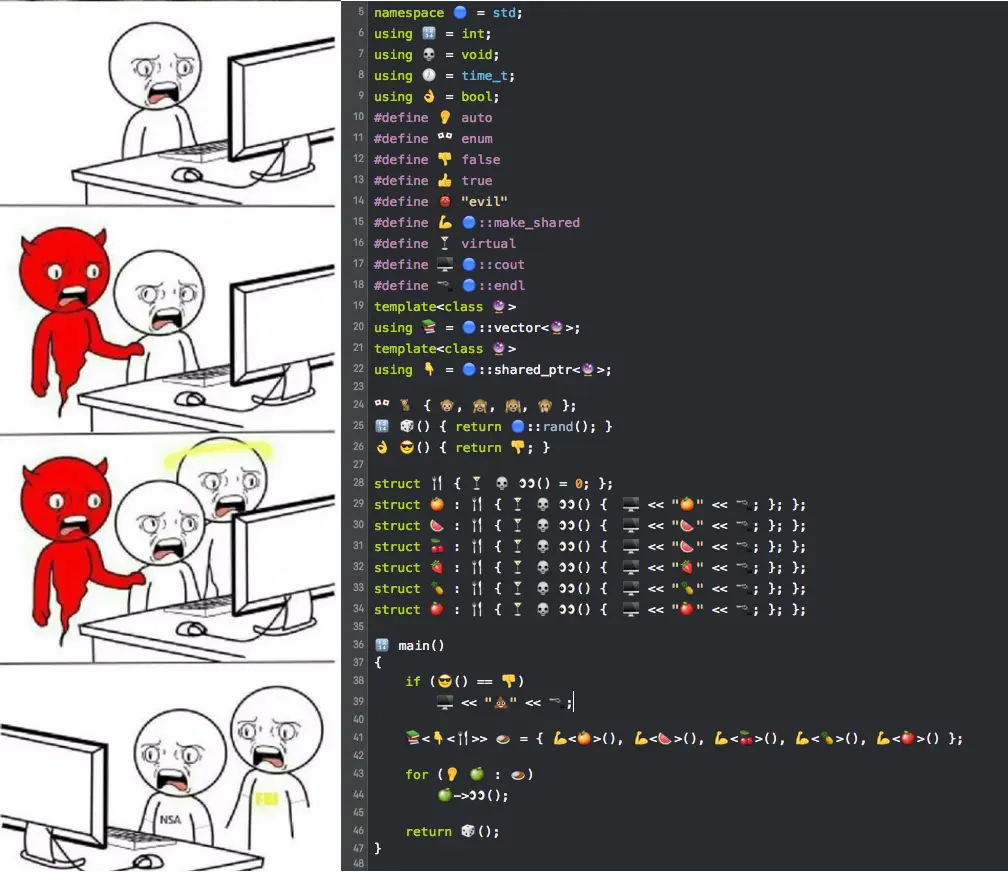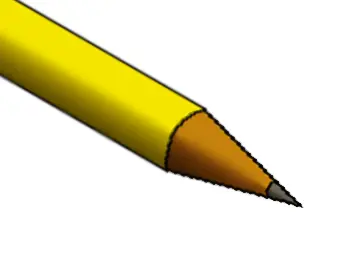- cross-posted to:
- programmer_humor@programming.dev
- cross-posted to:
- programmer_humor@programming.dev
cross-posted from: https://lemmy.zip/post/24335357
I don’t know much about coding, but I know Cuneiform isn’t an alphabet.
This is how we end up with snow crash.
Isn’t it all unicode at the end of the day, so it supports anything unicode supports? Or am I off base?
I think they exclude some unicode characters from being use in identifiers. At least last I tried it wouldn’t allow me to use an emoji as a variable name.
Another guy just posted emojis in their code in the comments no idea if it actually works
That code was C++ or something like that. Not GDScript.
I tested this on Godot 4.2.1. You can write identifiers using a different writing system other than latin and you are allowed to have emojis in strings, but you aren’t allowed to use emojis in identifiers.

Ah I’m unfamiliar with most languages I just use python and random others for personal projects
Coding must be a nightmare if you’re choosing programming languages at random 😱
But you must also be learning quite a lot.
There’s probably a rule that requires variables to start with a letter or underscore. Emoji are nor marked as letters. Something like
_👍will probably work.
Yes, but the language/compiler defines which characters are allowed in variable names.
Yes, but it still is about language, not game engine.
Albeit technically, the statement is correct, since it is more specific.
Yeah, but this particular language is a feature of the game engine. It’s its own thing called GDScript.
Oh, I didn’t know that, neat. Then there’s no space for nit-picking
Godot is neat. There is C# support as well if you find that easier, but coming from Unreal, it’s night and day. I know Unreal has so much more features, but for a hobbyist like me, Godot is much better. It’s just this small executable, and you have everything you need to get creative.
I thought the most mode sane and modern language use the unicode block identification to determine something can be used in valid identifier or not. Like all the ‘numeric’ unicode characters can’t be at the beginning of identifier similar to how it can’t have ‘3var’.
So once your programming language supports unicode, it automatically will support any unicode language that has those particular blocks.
Sanity is subjective here. There are reasons to disallow non-ASCII characters, for example to prevent identical-looking characters from causing sneaky bugs in the code, like this but unintentional: https://en.wikipedia.org/wiki/IDN_homograph_attack (and yes, don’t you worry, this absolutely can happen unintentionally).
Sorry, I forgot about this. I meant to say any sane modern language that allows unicode should use the block specifications (for e.g. to determine the alphabets, numeric, symbols, alphanumeric unicodes, etc) for similar rules with ASCII. So that they don’t have to individually support each language.
OCaml’s old m17n compiler plugin solved this by requiring you pick one block per ‘word’ & you can only switch to another block if separated by an underscore. As such you can do
print_แมวbut you couldn’t dopℝint_c∀t. This is a totally reasonable solution.That’s pretty cool
I can’t imagine how something like homograph attacks can happen accidentally. If someone does this in code, they probably intended to troll other contributors.
Multilingual users have multiple keyboard layouts, usually switching with Alt+Shift or similar key combo. If you’re multitasking you might not realize you’re on the wrong keyboard layout. So say you’re chatting with someone in Russian, then you alt+tab to your source code and you spot a typo - you wrote
my_var_xopyinstead ofmy_var_copy. You delete the x and type in c. You forget this happened and you never realized the keyboard layout was wrong.That c that you typed is now actually с, Cyrillic Es.
What do you say, is that realistic enough?
I use multilingual keyboard layouts, so I know that at least on Windows the selected layout is specific to each window. If I chat with someone in one language, then switch to my IDE, it will not keep the layout I used in the chat window.
But I also have accidently hit the combination to change layouts while doing something, so it can happen. I’m just surprised that Cyrillic с is on the same key as C, instead of S.
Ssh! 🫢 You’ll ruin the joke!
😨
Okay but how does starting a secure shell help?
Are you serious? I just explained that to you two seconds ago
Well for one, it encrypts all communications so that people can’t snoop on what you’re doing.
Bro thats fucking amazing 😂
Ea Nasir over here selling subpar code now
It really bugs me when people don’t comment their code at all. I have no idea what this is supposed to do.
Duh
You can’t trick me, I know a bullet hell when I see one.
Thanks, I hate it
Don’t you mean 𒁷𒀱𒀉?
Let’s hope Ea-nāṣir’s code is better than his copper.
I hear it’s prone to Rust.
Security by
ObscurityAntiquityBecause it supports Unicode as variable/class/function names and Unicode includes all the characters humans have ever used, even dead languages (I assume for historians to digitize ancient texts?)
Still more readable than APL
Iltam sumra rashupti ilatimmoment 🗿Wtf I just said these words out loud and the furniture started floating o.o
https://www.soas.ac.uk/baplar/recordings/ammi-ditanas-hymn-istar-read-k-hecker
So i guess iltam = goddess and ilatim = gods?
zumrā = praise be (to) and rašubti = fearsome being?
now that’s job security

Thank you for this cursed knowledge.
May I introduce you to emojicode…
A little LESS chaotically, you can use emojis to name objects in Blender now… Which, I dunno, could be kinda fun in the right doses.
This picture had me progressively laughing harder as it progressed though LOL.
Am I blind? I can’t see where 👀 is defined.
Take a look at all the struct definition. It’s a pure virtual method of 🍴 with a bunch of overrides in the structs that inherit from 🍴.
Oh, right, using the same function name in multiple structs is what threw me off
















